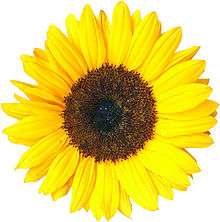Sunflower (mathematics)

In mathematics, a sunflower or -system[1] is a collection of sets whose pairwise intersection is constant. This constant intersection is called the kernel of the sunflower.
The main research question related to sunflowers is: under what conditions does there exist a large sunflower (a sunflower with many sets)? The -lemma, sunflower lemma, and sunflower conjecture give various conditions that imply the existence of a large sunflower in a given collection of sets.
Formal definition
Suppose is a universe set and is a collection of subsets of . The collection is a sunflower (or -system) if there is a subset of such that for each distinct and in , we have . In other words, is a sunflower if the pairwise intersection of each set in is constant.
Δ-lemma
The -lemma states that every uncountable collection of finite sets contains an uncountable -system.
The -lemma is a combinatorial set-theoretic tool used in proofs to impose an upper bound on the size of a collection of pairwise incompatible elements in a forcing poset. It may for example be used as one of the ingredients in a proof showing that it is consistent with Zermelo-Fraenkel set theory that the continuum hypothesis does not hold. It was introduced by Shanin (1946).
Δ-lemma for ω2
If is an -sized collection of countable subsets of , and if the continuum hypothesis holds, then there is an -sized -subsystem. Let enumerate . For , let . By Fodor's lemma, fix stationary in such that is constantly equal to on . Build of cardinality such that whenever are in then . Using the continuum hypothesis, there are only -many countable subsets of , so by further thinning we may stabilize the kernel.
Sunflower lemma and conjecture
Erdős & Rado (1960, p. 86) proved the sunflower lemma, stating that if and are positive integers then a collection of sets of cardinality at most contains a sunflower with more than sets. The sunflower conjecture is one of several variations of the conjecture of (Erdős & Rado 1960, p. 86) that the factor of can be replaced by for some constant .
The special case of this conjecture for was proved in 2016.[2]
References
- Deza, M.; Frankl, P. (1981), "Every large set of equidistant (0,+1,–1)-vectors forms a sunflower", Combinatorica, 1 (3): 225–231, ISSN 0209-9683, MR 637827, doi:10.1007/BF02579328
- Erdős, Paul; Rado, R. (1960), "Intersection theorems for systems of sets", Journal of the London Mathematical Society, Second Series, 35 (1): 85–90, ISSN 0024-6107, MR 0111692, doi:10.1112/jlms/s1-35.1.85
- Jech, Thomas (2003). Set Theory. Springer.
- Kunen, Kenneth (1980). Set Theory: An Introduction to Independence Proofs. North-Holland. ISBN 0-444-85401-0.
- Shanin, N. A. (1946), "A theorem from the general theory of sets", C. R. (Doklady) Acad. Sci. URSS (N.S.), 53: 399–400
Notes
- ↑ The original term for this concept was "-system". More recently the term "sunflower", possibly introduced by Deza & Frankl (1981), has been gradually replacing it.
- ↑ Kalai, Gil. "The Erdos-Szemeredi Sunflower Conjecture is Now Proven.". Retrieved 13 May 2017.